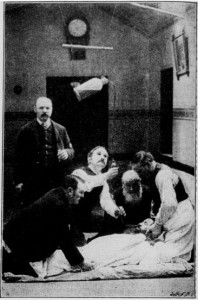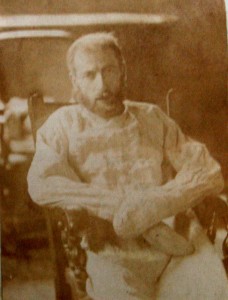
Sarah Chaney is a PhD student at the UCL Centre for the History of Psychological Disciplines and co-organiser of the Damaging the Body seminar series. This post, about food, physical restraint, and Victorian psychiatric treatment, arises from one element of her PhD research, and is written in connection with a forthcoming event in Bristol on 28th June.
In 1858, Dr Harrington Tuke published an article in the Journal of Mental Science (the major journal for asylum psychiatrists in England) on the topic of force-feeding. This was not an unusual topic for the profession, and was frequently discussed in the pages of this journal, in both articles and correspondence: refusal of food was also a common symptom of illness recorded in asylum casebooks.

An image from the British Medical Journal (1894) showing Dr William Whittington Herbert force feeding a patient (Wellcome Images).
The “non-restraint” movement of the 1840s had encouraged attention to physical methods of compulsion within psychiatric hospitals that, previously, may have called for little comment. Harrington Tuke, like many other writers in the following decades, regarded “forced alimentation” as a last resort. Although death from what was usually termed “exhaustion” was a real concern for physicians, he emphasised that the asylum doctor must consider his position carefully. “Any expert surgeon can without much difficulty feed a reluctant patient by force,” he wrote. “It is the higher office of the practitioner in lunacy to overcome morbid repugnance to food by gentle and patient soothing, and to combat the dangerous and distressing delusions of his patients, if possible, without having recourse to coercive and apparently harsh measures.” S.W.D. Williams, House-Surgeon at the Northampton General Asylum, agreed, suggesting that force-feeding was ultimately only necessary in around ten per cent of cases in which patients refused food.
My research focuses on nineteenth-century asylum psychiatry. Reading asylum casebooks and annual reports, I have often come across what seems to me a strange paradox: the advocacy of non-restraint coexisting with the practice of force-feeding.
In the decades following Harrington Tuke’s article, debate over the appropriate moment to resort to force-feeding decreased in magnitude, and the procedure appears to have become widely accepted as a necessary (and prompt) response to refusal of food in the asylum: by the late 1880s at the Bethlem Royal Hospital, the “stomach pump” seems to have made an appearance the moment a meal was missed (which had not been the case in the 1850s). On the passing of the 1890 Lunacy Act, restraints “used only for the purpose of forcible feeding, and merely held by attendants, not tied or fastened” were considered outside the realm of mechanical coercion, and therefore did not have to be recorded in the asylum restraint book. But why, given the continued repugnance of many asylum physicians to mechanical restraint (some even complained that the 1890 Act appeared a “retrogressive step”, by effectively legitimising its use) do they appear to have accepted force-feeding so readily?
Williams’ analysis of the cases under his care suggests one of the underlying issues here: the strong association made by many physicians between digestive problems and mental disease, in particular the diagnosis of melancholia. Williams claimed that “in no cases can psychical derangement be traced more surely to a physical causation than in suicidal melancholia attended by derangement of the digestive organs”, while “all delusions bearing on food are, more or less, owing to dyspepsia.” This association of melancholia with the digestive system was a long-running one. On the physical examination carried out on patients at the Bethlem Royal Hospital in the 1880s and 1890s, the first item to be recorded was “Tongue – Digestive System” (Williams similarly claimed that the first signs of disordered digestion appeared on the tongue). A decade later, J. Milner Fothergill at the West London Hospital claimed that neurologists had located emotions and certain organic processes in the same area of the brain, which explained “how the emotions sympathise with the organic processes, especially those located in the abdomen, and so [we] can see melancholia in a new light; and can comprehend how mental depression may accompany, or wait upon, and depart with abdominal disturbance.”
Such an idea appears to have strong parallels with classical humoral theory: the idea that an excess of black bile, produced in the spleen, might spill into the stomach and intestines and cause both digestive turmoil and melancholy. The association between emotion and digestion was thus a long-held tradition: however, late nineteenth-century writers like Fothergill claimed the backing of modern science, rather than humoral theory. Digestive problems might thus be considered the first sign of emotional turmoil. George Savage claimed that in “Hypochondriasis of the Digestive Tract … which by many would be called true hypochondriasis”, emotional disorder frequently appeared, due to the “natural association” between the emotions and the stomach.
While parallels clearly could be (and sometimes were) made between mechanical restraint and force-feeding – both might be deemed convenient rather than curative, and cruel or otherwise hurtful to the patient – the two treatments were usually regarded quite separately in nineteenth-century psychiatry. The consumption of food was deemed to be directly associated with health: both physical and, perhaps more tellingly, mental. In asylum casebooks, weight gain was frequently recorded as a sign of recovery – the term “fat and well” makes a regular appearance in descriptions of convalescent patients. Force-feeding was thus almost invariably regarded as a medical treatment, and not a matter of convenience: mechanical restraint was usually claimed to be the reverse. Yet both can easily be regarded as much more ambiguous. Just as the decision as to whether a patient was dangerous to himself or others was subjective, so was the decision as to whether someone had consumed enough food, or at what stage weight loss might be dangerous to life.
The subjective nature of concerns around self-inflicted damage to the body has been the topic of a number of events I have co-organised, funded by the Wellcome Trust. The final event of the series, taking place on Thursday 28th June in Bristol, will focus on the idea of disordered eating. Four expert speakers will explore the topic of “Fasting and the Famished Body: Disordered Eating and the Gendering of Self-Starvation”. For more information on this and the overall series, visit the Damaging the Body project website.
Sarah Chaney.


It seems (to me anyway) understandable that the ancients would intuitively associate eating and emotions. When eating is not disordered, we anticipate eating with pleasure and feel satisfaction when full. A curious development is that bariatric surgery appears to alter the brain (which, of course, is not the same thing as altering the emotions). It appears to change hormone production in the digestive system, which in turn alters the reward center (less craving for food, lower insulin) & the thalamus (causing cognitive problems of memory, attention, and concentration). There’s an interesting article on this in a recent issue of New Scientist (May 19-25 http://bit.ly/M6vfCi). (Unfortunately it’s behind a paywall.)